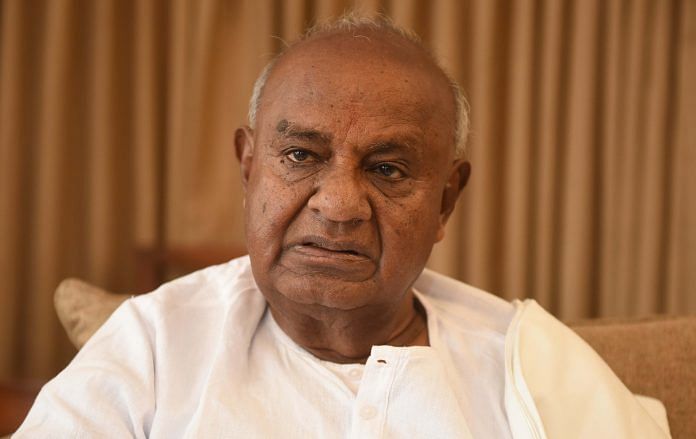The clout of ideology-agnostic power-seekers that had diminished after 2014 seems to be returning, from UP to Karnataka.
We are all taken by surprise in the summer of 1996 when the name of one H.D. Deve Gowda emerged as the likely prime minister of the unlikely United Front coalition to keep the BJP out. Old-timers on the political beat knew him as that former Karnataka MP and chief minister who never missed a day in Parliament. But he also sat on the back benches and said very little. I had never even seen the man, so I asked for time to meet him.
He gave me an audience in the capital’s Karnataka Bhavan and we sat across a table as might be at a petition writer’s desk in a court premises.
Can you, sir, Mr Deve Gowda, who nobody knows, who has almost no MPs, think of becoming the prime minister of India, I asked.
Already hunched, he bent some more, until his face was almost touching the desk’s surface and his wide forehead jutted out at me. He rubbed the fingers of his right arm slowly across it and said, calmly, “What is written here, in my fate, my friend, nobody can change”. He proved right. All of us then memorised and learned to correctly pronounce his full name: Haradanahalli Doddegowda Deve Gowda.
For the record, his government produced India’s second most reformist budget after Manmohan Singh’s in 1991. This was P. Chidambaram’s “dream budget” of 1997 which brought in the Voluntary Disclosure of Income Scheme (VDIS), besides much else. He also set up the National Disinvestment Commission which initiated the PSU listing and sale process. That despite the fact that he mostly slept on the job and our photographer kept catching him in that act.
He was so irritated by the pesky photographer that he got his factotum and information and broadcasting (besides civil aviation) minister C.M. Ibrahim to invite me for tea.
“Why do you give the poor man so much trouble?” he asked.
“But what can I do, if the camera catches him sleeping all the time?” I told him the truth.
“Uski problem samjho baba,” said Ibrahim. “From 9 am to 10 pm he is the prime minister of India. From 10-12 he’s the chief minister of Karnataka. Then from 12 until 2 he’s the deputy commissioner of Hassan. Then he sleeps and is up for pooja at 4.30. Toh kya karey phir?” (So what can he do?)
Gowda was fated to be prime minister, but only for a short time and we all thought then that the Gowda saga was over. He retired to his home state and we forgot about him. We said many unkind things about him, an accidental prime minister was possibly the least unkind of all. I also called him a prime minister on daily wages as his ‘Tom and Jerry’ with Sitaram Kesri carried on.
But, almost a decade later, just when we had forgotten him even as a joke, Gowda returned to our lives. Now in the fog of his favourite son, H.D. (Haradanahalli Devegowda) Kumaraswamy. The 46-year-old then rose as the new chief minister of Karnataka in as big a surprise as his father. With one critical difference. The father had become prime minister of India to keep the BJP out, with the Congress supporting him from outside. Now, the son had become chief minister in partnership to keep the Congress and the “secular” forces out. Even then, Kumaraswamy’s JD(S) was only the third largest party with 58 seats while the BJP had 79 MLAs and Congress had 65. There were motivated rumours that the father was so cross at this betrayal that he fell sick, landed in hospital. I haven’t yet met anybody politically knowledgeable who was impressed with that propaganda.
“Your father became prime minister of India in a coalition to keep the BJP out, how do you now justify becoming chief minister with the BJP’s support,” I asked Kumaraswamy in our conversation on NDTV’s ‘Walk The Talk’.
“My father, sir, made a big mistake by becoming prime minister of India,” he said and explained why.
“He lost focus and control over his party in our own state and that’s why we suffered for so many years,” he said. We have to all learn from the Dravida parties, my friend, Kumaraswamy said. Build and keep power in your state and take a share from whoever comes to rule the Centre.
This was an important lesson in my education in Indian politics, which still continues. That there is this significant group of regional/state parties in India whose ideology is totally fungible with power. No Left, Right or centre. DMK, AIADMK, JD(S), JD(U), RPI and so on. L.K. Advani used to articulate it rather precisely. There are five parties that consider us (BJP) anti-national: Congress, Left, SP, RJD and Muslim League. Besides those five, we can have any others in our coalition.
The clout of these ideology-agnostic power-seekers had seemed to diminish after the 2014 election. The return of junior Gowda, Kumaraswamy as chief minister now (even with less than half the numbers of his partner Congress) tells us two things. One, that the power of the smaller parties with vote banks in their respective regions may be returning. You can see it in the SP and BSP combining and making Congress marginal in Uttar Pradesh and Sharad Pawar’s NCP seeing new possibilities in Maharashtra. The second, that their maker has taken his time writing some remarkable stuff on the Gowda foreheads. And what’s written in the fate there, can’t be changed.



